A young woman dressed in absolutely elaborate Kimono bustles about through the streets of Gion. Her white make up shines reflecting the bright sun or dim moon depending on the time of day. Her red lips look like a rose petal laying gracing on freshly fallen snow. She is an important symbol of Japan. One that is built up over hundreds of years of tradition in the arts of her country. She is a Geisha, or Geiko as they are called in Kyoto. Though some aspects have changed through the years they are still artists and still symbols of Japan. But there is a problem, with all of the economic and cultural differences in the Geisha and Maiko community, Geisha and Maiko are becoming more and more rare, some might even consider them a dying culture. While there were once tens of thousands of Geisha and Maiko, there are now only a couple thousand at most, Geisha only reaching numbers in the hundreds.
The popularity of Maiko and Geisha have cause something interesting to happen. Tourists who visit Kyoto are now able to be dressed up as Maiko for a fee at establishments called “Henshin” Studios which are popping up more and more around Kyoto, depending on the price you want to pay certain studios can make you look very close to real, even use your real hair instead of a wig. After they are dressed up they are given a mini photoshoot in their new pretty kimono and painted faces and are allowed to wander through the streets of Kyoto where more tourists take pictures of them, mistaking them for real Maiko. There are select features that these Henshin studios get wrong on purpose, because if they make them look absolutely authentic, they risk getting shut down by the authorities. Before I point these characteristics out I would first like to give some insight to becoming a Maiko in this modern era. I think one of the best ways to do this is to explain the different stages that they go through.
Back in the old days young girls were sold to Okiya (houses where Geisha live) to become Maiko and eventually Geisha. These days girls can choose to join an Okiya at the age of 15. At this point, they are “Shikomi” this means they basically work as a maid to the Okiya. The okaa-san (Mother and owner of the okiya who basically funds the girls training, provides the food and kimono and teaches them valuable lessons such as how to walk in a kimono and how to have witty conversation with her future patrons, also how to play games that she will eventually be playing with her future patrons) wants to break and make the young Shikomi. The Shikomi must listen to the okaa-san and do what she says with absolute cooperation. If she doesn’t, she risks being kicked out of the okiya. It’s also important to know this is the very beginning of her training, and possibly the most difficult. Not only must she stay up late waiting for her Maiko and Geiko housemates to help them remove their kimono and makeup, sometimes this can be as late as 3 in the morning, but they must also wake up the next day to go to their lessons and do their chores. Along with this, they cannot speak to their family or friends for 6 months, which is about the amount of time that this stage lasts, depending on how well the okaa-san thinks the Shikomi is doing. Finally a Shikomi will take a difficult dance and arts test to see if they are fit to go to the next level.
The next stage is a Misedashi. Shikomi graduate to this level after 6 months of working. This will be the first time she will wear the elegant kimono and famous white makeup. This will also be the first time her hair will be worked into the first of many complicated hairstyles that she will wear through her career as a Maiko. During this stage the young Maiko will take on an “onee-san” translated to Older sister. This Geiko will be responsible for introducing the Maiko to several of her future patrons, and in the next level they will take her little sister to several of the events and parties that she will attend. This stage is also the one in which the Okaa-san will introduce the young Maiko to the various people who will help her in her career, namely the ochiya, or tea houses, the wig and hair dressers, and the various kimono sales people. This is a very exiting time for the Maiko and is a public event complete with huge banners with the Maikos new professional name painted across them and a party at the end of her debut as a maiko. This name will contain elements of her Okiya and will be picked by a person who’s profession is to choose names that will bring the Maiko luck and prosperity. This is a lot more complicated than it seems, because not only must they use elements from the okiya, but stroke order and number are also very important to be considered.

A Maiko in her Misedashi stage. Those two silver hair ornaments in the front of her hair are the defining characteristic along with her very tall ohogo. Notice only her bottom lip is also painted
The next stage is one of the most popular for tourists to dress up as. It’s their Minarai stage, the one where she learns by watching, which is what she will be doing for about half of this stage. Along with the hairstyle and makeup and beautiful kimono, she now has a very recognizable hair ornament with dangling pieces of silk which end about at her chin. Now that she is a recognized member of the Geiko community she will be allowed to go with her Onee-san to her various event, whether invited or not though patrons normally happily welcome the new Maiko. The first part of this stage she will simply sit and watch her older sister preform and converse with her patrons. After a while she will do small performances and converse with some of the patrons, though under the close watch and guard of her dear Older sister. This stage will last a year, and sometimes Minarai are referred to as junior Maiko because they are not yet able to preform on their own without the assistance of either her onee-san or a more senior Maiko.
Finally the girl has reached the stage where she can officially become a Maiko. At this stage she can go to her own parties and banquets and can preform at festivals but will always join her onee-san at her events. A maiko will go through a few more hair styles and her predominately red collar will slowly start to turn white, at which point she will graduate to become a Geiko. Normally this stage will last about 4 to 5 years and both her top and bottom lips will be painted. She will also get rid of the recently mentioned hair ornament with the pieces of dangly silk replacing it with different hair ornaments that will determine what level she is at.
As I mentioned before, after 4 or 5 years a maiko will graduate into a geiko in which they will undergo a ceremony which just as her debut as a maiko, will be very public as she debuts as a Geiko. This ceremony is called Erikae, otherwise known as the turning of the collar where the collar will be turned to completely white. Normally girls make it to this level around the age of 20. But this isn’t the only thing that changes, a Geiko will get a totally new hair style, which can actually be a wig if she likes (This has changed since the old days because the harsh hairstyles used to cause premature baldness in girls, now most Geiko prefer to use wigs instead of their natural hair.) The Geiko will also get a completely new style of Obi (One that isn’t as high up but more like traditional obis, this is to give them more of a mature look, it also has more of a square knot in the back instead of the long dangling obi knots in the back that Maiko wear) and she is given a more mature kimono, instead of the colorful and bright kimono with the long sleeves that Maiko wear, they have more toned down solid colors with details of nature painted on them, their sleeves are also much shorter like a tomesode instead of the furisode. If a Geiko has paid off all of her debts to the okiya she can either leave to live independently, open her own ochiya, or continue living at the okiya to continue working for them and being provided for and keep paying them back.To be honest, not many Maiko make it to the level of Geiko because of how difficult the lifestyle is. And even when girls make it to Geiko, they often retire within 5 years of their debut. This can be because of any number of reasons, whether they are tired of the lifestyle, if they want to pursue a different career, or if they want to marry. Either way, these Geiko are highly celebrated and have a huge fan base, not only around Kyoto and Japan but all over the world.
Some other information about Maiko and Geisha:
~No they are not prostitutes. Sex is not a part of their lifestyle unless they choose to have sex with a person, even then it’s not in their job description and they are not paid for it.
~They will not normally stop to have their pictures taken with tourists, they are busy and need to get to their appointments, their patrons not only pay for the time that they are with them, but also pay their fee while they are trying to make it to their appointments.
~You will not normally see them in their full regalia before 5pm, I’ll explain later
Alright, that was a bit long, and even longer to type out, but I think it’s important to know about the different stages to geisha-hood to understand a lot of the different ways to spot a tourist who is simply playing dress up. Don’t get me wrong, it’s very nice to see all these women dressed up in beautiful kimono and white faces, but some tourists get rowdy and do things that are distasteful, these actions can give others who assume these girls to be real a bad impression of real Maiko and Geiko. Also, who wouldn’t want to get a picture of a real Maiko or Geiko as they bustle through the streets of Gion? At the end of this tutorial on how to tell the real from the fake, I will give you a quick lesson on how to catch real Geiko and Maiko~.
First let’s look at a quick picture,
First off, do you remember when we were discussing the Minarai? You can see this girl wearing the hair ornament that is characteristic of a Minarai junior maiko, yet she is wearing something extra. Both of her lips are painted. True Minarai only have their bottom lip painted. Also, look at the collar of her under kimono. It has colors that the under kimono of a maiko or geiko would never have. Those colors would only be red, gold, and white (or a creamy color), this under collar has all sorts of colors like blue, purple, green, orange, in fact there’s very minimal reds, which wouldn’t happen for a minarai.
There are three main things I want to point out with this picture. First is the age. Remember, maiko at this stage are only about 15 or 16 years old. This woman is quite a bit older. Second, and this is a bit difficult to see, but you might be able to see what I’m talking about around her hair line and especially by her ear, this woman is wearing a wig. I saved saying this until now, but another aspect that is concentrated on in the shikomi stage is growing out your hair. A Maiko will not wear a wig unless it’s for a special occasion in which her hair isn’t made into the traditional “over ear” style like a festival where they preform plays. But don’t take real hair as being a clear sign of a real Maiko, a tourist can pay a fee to have her natural hair worked into either the full style or a half wig, which is pretty tricky to spot. Finally look at her under collar once more, it’s completely white, which is way too much white for that stage Maiko.
There are quite a few signs with this tourist, besides the signs I have already mentioned she is wearing Okobo which are simply too short, though a maiko may wear shorter okobo on certain occasions, it wouldn’t be while she is simply walking to work. She also has her kimono tied up. Maiko are trained to be able to handle their kimono with grace, carrying it while she walks, the only time she would have it tied up is if she was doing a performance that called for her kimono being tied up or if she had her hands full, and not only with that basket. Speaking of that basket, it’s far too empty, that basket should be filled with all of the things a Maiko could possibly need to go out and entertain her guests, that means it should practically be bubbled with stuff. Finally, her kimono is tucked incorrectly at the shoulders, it should be tucked practically up on top of her shoulder instead of halfway down her upper arm.
Now there are girls who can dress up past the Minarai stage, I don’t exactly know how to determine if those are real or fake, though I am confident that all the pictures I posted in the section explaining the different stages is correct. I will research that and post what I have found when I can. Here are some other tips on how to tell if a girl is a real or fake maiko.
~If you find a girl in her full regalia in the middle of the afternoon, chances are she’s a tourist and nothing more. In fact you may walk right past a real maiko in the middle of the day without even knowing it. (I’ll provide a picture of some real maiko without their outfits later)
~Just because a girl has a seal on the bottom of her obi doesn’t necessarily mean she’s real. These Henshin places have seals of their own that they put on.
~A maiko probably won’t be traveling through a populated area, they are like celebrities and already have a hard enough time getting from one place to the other without being mauled by the paparazzi, they generally take the backstreets away from all of the people.
~A maiko or Geisha does not need an escort to get to their places or help them walk. So if you see one holding the hand of someone else or even of another Maiko, chances are they are fake. Now, there are a group of people that assist them in keeping the paparazzi in line, though they do not need their assistance in terms of looking where to go or being able to handle themselves.
~Maiko wouldn’t be stopping to take pictures with tourists, as I had mentioned earlier, her patrons pay for the time it takes for her to get to her place as well.
~ It’s also important to note that Maiko and Geiko wear kimono that correspond with the season. You wouldn’t see one wearing a kimono intended for Summer in the winter, or a Fall kimono in the spring, think of it like this; you wouldn’t wear something that you would wear in the winter during the summer either. You would look silly.
~Along with the kimono corresponding to the seasons, the Kanzashi hair ornaments also correspond to the seasons and months, so, if you caught a Maiko or Geiko and aren’t sure if they are real or fake, it’s always smart to look at a kanzashi chart. Here’s one that I found but if you don’t see yours there, then you may try to find another source. http://www1.odn.ne.jp/maya/english/kanzashi.htm
Now, how to catch a real Maiko or Geiko out and about? One of the best ways is by going to one of their parades or festivals, but if you don’t find yourself there at the right time, I would recommend hanging out by the tea houses and okiya around 5pm, that’s when they come out. If you’re around before then look out for the famed hair style. If you do happen to find a real Maiko be prepared for the hordes of paparazzi, and please don’t feel offended if she doesn’t stop to take a picture with you or poses for a picture, they are on the clock after all. Also, please please please don’t shout out to them or try to touch them! As one famous Maiko said “We are not Mickey mouse and this is not Disney World, we are not here to entertain the public, we are here to entertain our patrons.” To touch the kimono of a Maiko or Geiko would be like dumping mud on a Ferrari, after all, those kimono can cost upwards of 30,000 dollars. If you’re brave, you can always ask nicely to take a picture of them, but do it quickly and always be respectful.

Some maiko out of their full regalia. You can see they have their hair still in the traditional style, which can stay in that style for a week.
On a couple final notes I am in no way an expert. I have used several references but have coppied and pasted none of it. This is just a conglomeration of all the information I have acquired over a few months of research. If I get any information wrong, please let me know and I will fix it right away. I own NONE of these pictures, they are all from different sources I have found through google. If you have any questions or comments please feel free to post them, I will happily view and respond to them~

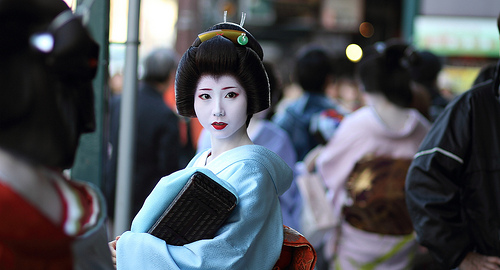

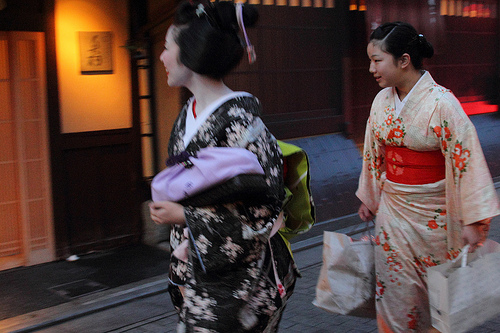
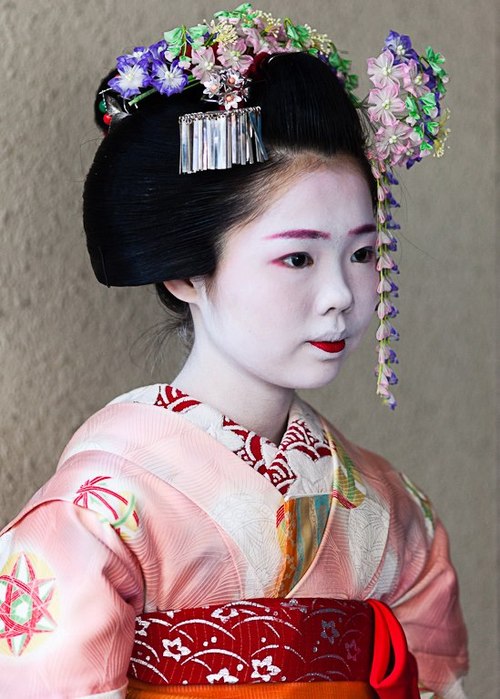


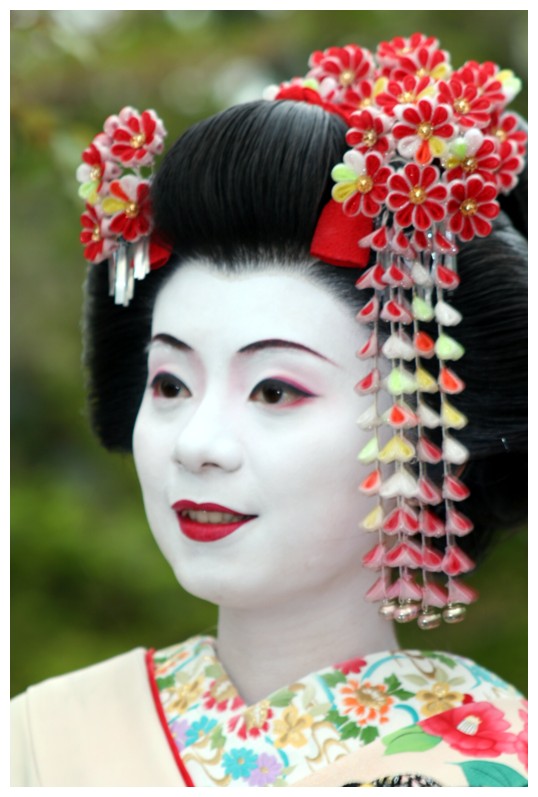
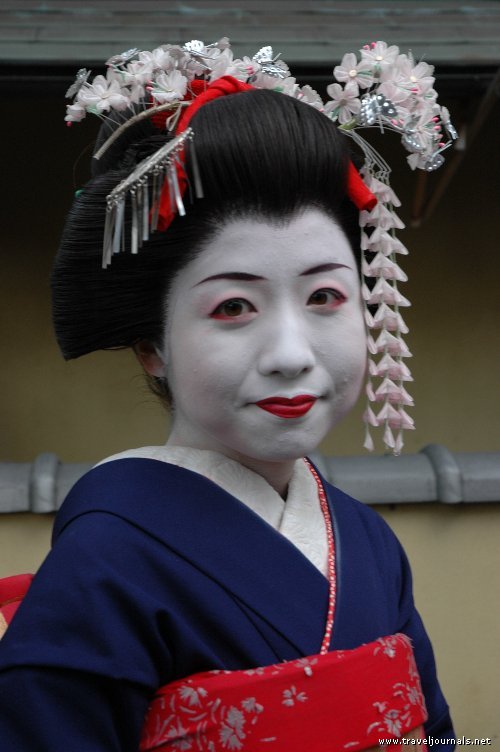
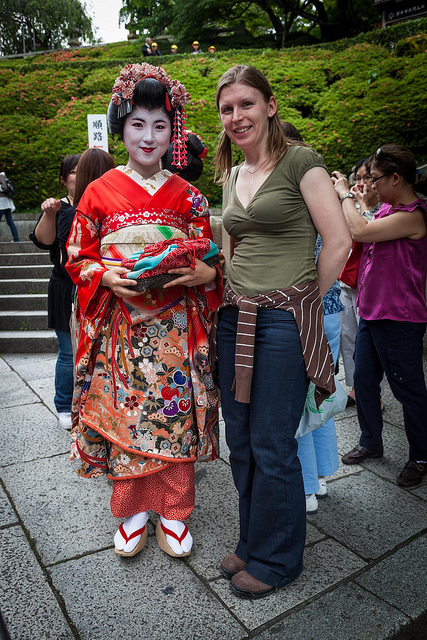
Wow, this is really in depth. Only a couple of little contradictions I would point out – that is, I do see maiko dressed in full costume any time from mid-morning. Maybe they have lunch engagements. Also there are misedashi and erikae walks where the full regalia in all its glory is on display. And sometimes maiko and geiko will stop to pose if asked very nicely and if not in too much of a hurry. I have never asked but when I had my daughter with me and she was still a child, they would pose with her. In fact she would ask and usually they agreed.
What a wonderful article about a beautiful tradition and a lovely group of women. I am very appreciative of your pointing me in this direction so that I will honor the right practice in the future.
Oh my thank you very much ^^ I’m utterly fascinated by the whole culture (If you couldn’t tell) You’re so lucky to be entertained by them! How did you get the chance to experience something so wonderful, if I may ask? ^^
Thanks for all the information. It is very interesting reading about all the differences and how to spot them. Now that I know I didn’t get to see real Geisha in Kyoto I am a bit disappointed.
Hey don’t be. It was still a fun experience wasn’t it? And now that you know how to tell the difference between the two, you can go back and catch some real ones ^^
That is so informative!
And I have a question, so geisha are still existing in Kyoto?
Oh yes! In Kyoto and Tokyo in fact ^^ Though their are less than there have been in past years but there are still thousands left ^^ I’m actually working on a post now that catalogs a lot of the Maiko and Geisha of Gion Kobu, I still have a long while to go though before I get them all ^^
You really study this all by yourself? WHOA
And did you ever go to Japan?
I haven’t gone to Japan yet, though it’s a dream of mine ^^ And yes, I study this but I wouldn’t necessarily say it’s all by myself. There’s a huge following of Geisha and Maiko, and I’ve actually befriended someone who has been studying the culture much longer than I have so she normally answers any questions I would want to ask her ^^ Though I never want to bother her ^^
I’ve always wanted to be a geiko but I can never become one (-_-)
Why would you think you wouldn’t be able to become one? You don’t have to be Japanese to become a Geiko and you wouldn’t necessarily have to be a full Geiko to entertain with the Geiko, you could always become what’s called a Jikata Geiko who accompanies the Maiko and Geiko to the various engagements~